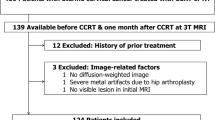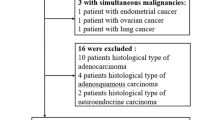Abstract
Purpose
To explore the value of histogram analysis of dynamic contrast-enhanced magnetic resonance imaging (DCE-MRI) quantitative parameters and apparent diffusion coefficient (ADC) values in predicting the neoadjuvant chemotherapy (NACT) response for cervical cancers.
Methods
Sixty-three patients with pathologically proved stage IB2–IIA2 cervical cancer from March 2013 to January 2017 were retrospectively analyzed. They were divided into two groups on the basis of therapeutic response: the significant response (SR) group, which contains complete response patients and partial response patients, and nonsignificant response (non-SR) group, which contains progressive diseases and stable diseases. Clinical characteristics, DCE-MRI parameters (Ktrans, Kep, Ve), and ADC values before NACT were analyzed and compared between the two groups.
Results
SR group and non-SR group were documented in 35 and 28 patients. The mean Ktrans value, 90th percentile Ktrans value, maximal Ktrans value, and 90th percentile ADC value of tumors in SR were significantly higher than those in non-SR group (P = 0.012, P = 0.022, P = 0.005, P = 0.033, respectively), and the mean Ve value and 10th percentile Ve value of tumors were significantly lower in SR group (P = 0.041, P = 0.033, respectively). Kep values did not significantly differ between SR and non-SR. The 90th percentile Ktrans value combined with the 90th percentile ADC value had the highest area under the curve at 0.740 (P = 0.003) to predict NACT effectiveness.
Conclusion
Histogram analysis of DCE-MRI multi-parameters combined with ADC values may serve as sensitive indicators for predicting NACT effectiveness in cervical cancers.







Similar content being viewed by others
References
Bray F, Ferlay J, Soerjomataram I, Siegel RL, Torre LA, Jemal A (2018) Global cancer statistics 2018: GLOBOCAN estimates of incidence and mortality worldwide for 36 cancers in 185 countries. CA Cancer J Clin 68:394–424
Amini A, Robin TP, Stumpf PK et al (2018) Rising rates of upfront surgery in early locally advanced cervical cancer: what factors predict for this treatment paradigm? Int J Gynecol Cancer 28:1560–1568
Platt SL, Patel A, Humphrey PJ, Al-Booz H, Bailey J (2019) Completion surgery after chemoradiotherapy for cervical cancer—is there a role? UK Cancer Centre experience of hysterectomy post chemo- radiotherapy treatment for cervical cancer. J Obstet Gynaecol 39:68–73
Cetina-pérez L, Serrano-olvera A, Flores-cisneros L et al (2018) Epidemiological profile, gastrointestinal toxicity, and treatment of pelvic cancers in patients managed with radiotherapy to the abdominal pelvic area. Rev Invest Clin 70:112–116
Ma Y, Zhao G, Qi J et al (2018) Neoadjuvant brachytherapy and chemotherapy followed by radical surgery for stage IB2 and IIA cervical cancer: a retrospective comparison with chemoirradiation. Mol Clin Oncol 8:623–627
Li F, Guo H, Qiu H et al (2018) Urological complications after radical hysterectomy with postoperative radiotherapy and radiotherapy alone for cervical cancer. Medicine (Baltimore) 97:e0173. https://doi.org/10.1097/md.0000000000010173
Tomao F, Corrado G, Peccatori FA et al (2016) Fertility-sparing options in young women with cervical cancer. Curr Treat Options Oncol 17:5
Fu C, Feng X, Bian D, Du W, Wang X, Zhao Y (2013) Basic T1 perfusion magnetic resonance imaging evaluation of the therapeutic effect of neoadjuvant chemotherapy in locally advanced cervical cancer. Int J Gynecol Cancer 23:1270–1278
Shoji T, Takatori E, Furutake Y et al (2016) Phase II clinical study of neoadjuvant chemotherapy with CDDP/CPT-11 regimen in combination with radical hysterectomy for cervical cancer with a bulky mass. Int J Clin Oncol 21:1120–1127
De Jonge ET, Lindeque BG, Burger W, Nesland JM, Holm R (2000) Predicting response to neoadjuvant chemotherapy in patients with cervical carcinoma: can we do without any longer? Int J Gynecol Cancer 10:137–142
Mongula JE, Slangen BF, Lambregts DM et al (2015) Consecutive magnetic resonance imaging during brachytherapy for cervical carcinoma: predictive value of volume measurements with respect to persistent disease and prognosis. Radiat Oncol 10:252
Levy A, Caramella C, Chargari C et al (2011) Accuracy of diffusion-weighted echo-planar MR imaging and ADC mapping in the evaluation of residual cervical carcinoma after radiation therapy. Gynecol Oncol 123:110–115
Ni X, Tong Y, Xiao Y, Liao J, Chen Y, Wang M (2015) Diffusion-weighted magnetic resonance imaging in predicting the radiosensitivity of cervical cancer. Int J Clin Exp Med 8:13836–13841
Kim JH, Kim CK, Park BK, Park SY, Huh SJ, Kim B (2012) Dynamic contrast-enhanced 3-T MR imaging in cervical cancer before and after concurrent chemoradiotherapy. Eur Radiol 22:2533–2539
Lund KV, Simonsen TG, Hompland T, Kristensen GB, Rofstad EK (2015) Short-term pretreatment DCE-MRI in prediction of outcome in locally advanced cervical cancer. Radiother Oncol 115:379–385
Zhang Z, Wang Z, Zhao R (2018) Dynamic contrast-enhanced magnetic resonance imaging of advanced cervical carcinoma: the advantage of perfusion parameters from the peripheral region in predicting the early response to radiotherapy. Int J Gynecol Cancer 28:1342–1349
Fu C, Bian D, Liu F, Feng X, Du W, Wang X (2012) The value of diffusion-weighted magnetic resonance imaging in assessing the response of locally advanced cervical cancer to neoadjuvant chemotherapy. Int J Gynecol Cancer 22:1037–1043
Himoto Y, Fujimoto K, Kido A et al (2014) Assessment of the early predictive power of quantitative magnetic resonance imaging parameters during neoadjuvant chemotherapy for uterine cervical cancer. Int J Gynecol Cancer 24:751–757
Valentini AL, Miccò M, Gui B et al (2018) The PRICE study: the role of conventional and diffusion-weighted magnetic resonance imaging in assessment of locally advanced cervical cancer patients administered by chemoradiation followed by radical surgery. Eur Radiol 28:2425–2435
Meng J, Zhu L, Zhu L et al (2017) Whole-lesion ADC histogram and texture analysis in predicting recurrence of cervical cancer treated with CCRT. Oncotarget 8:92442–92453
Bhatla N, Berek JS, Cuello Fredes M et al (2019) Revised FIGO staging for carcinoma of the cervix uteri. Int J Gynaecol Obstet 145:129–135
Benedetti-Panici P, Greggi S, Colombo A et al (2018) Neoadjuvant chemotherapy and radical surgery versus exclusive radiotherapy in locally advanced squamous cell cervical cancer: results from the Italian multicenter. J Clin Oncol 20:179–188
Eisenhauer EA, Therasse P, Bogaerts J et al (2009) New response evaluation criteria in solid tumours: revised RECIST guideline (version 1.1). Eur J Cancer 45:228–247
Annede P, Gouy S, Haie-Meder C, Morice P, Chargari C (2019) Place of radiotherapy and surgery in the treatment of cervical cancer patients. Cancer Radiother 23:737–744
Zahra MA, Tan LT, Priest AN et al (2009) Semiquantitative and quantitative dynamic contrast-enhanced magnetic resonance imaging measurements predict radiation response in cervix cancer. Int J Radiat Oncol Biol Phys 74:766–773
Park JJ, Kim CK, Park SY et al (2014) Assessment of early response to concurrent chemoradiotherapy in cervical cancer: value of diffusion-weighted and dynamic contrast-enhanced MR imaging. Magn Reson Imaging 32:993–1000
Feng Y, Liu H, Ding Y et al (2019) Combined dynamic DCE-MRI and diffusion-weighted imaging to evaluate the effect of neoadjuvant chemotherapy in cervical cancer. Tumori. https://doi.org/10.1177/0300891619886656
Donaldson SB, West CM, Davidson SE et al (2010) A Comparison of tracer kinetic models for T1-weighted dynamic contrast-enhanced MRI: application in carcinoma of the cervix. Magn Reson Med 63:691–700
Dappa E, Elger T, Hasenburg A, Düber C, Battista MJ, Hötker AM (2017) The value of advanced MRI techniques in the assessment of cervical cancer: a review. Insights Imaging 8:471–481
Liu Y, Bai R, Sun H, Liu H, Zhao X, Li Y (2009) Diffusion-weighted imaging in predicting and monitoring the response of uterine cervical cancer to combined chemoradiation. Clin Radiol 64:1067–1074
McDonald K, Sebire NJ, Anderson J, Olsen OE (2011) Patterns of shift in ADC distributions in abdominal tumours during chemotherapy–feasibility study. Pediatr Radiol 41:99–106
Funding
This research received no specific grant from any funding agency in the public, commercial, or not for profit sectors.
Author information
Authors and Affiliations
Corresponding author
Ethics declarations
Conflict of interest
The authors declare that they have no conflict of interest.
Research involving human participants and/or animals
This is a retrospective study. The First Affiliated Hospital of Nanjing Medical University Research Ethics Committee has confirmed that no ethical approval is required.
Informed consent
Not applicable. None of the images in this manuscript contain identifying information.
Additional information
Publisher's Note
Springer Nature remains neutral with regard to jurisdictional claims in published maps and institutional affiliations.
Rights and permissions
About this article
Cite this article
Zhang, A., Song, J., Ma, Z. et al. Combined dynamic contrast-enhanced magnetic resonance imaging and diffusion-weighted imaging to predict neoadjuvant chemotherapy effect in FIGO stage IB2–IIA2 cervical cancers. Radiol med 125, 1233–1242 (2020). https://doi.org/10.1007/s11547-020-01214-x
Received:
Accepted:
Published:
Issue Date:
DOI: https://doi.org/10.1007/s11547-020-01214-x




